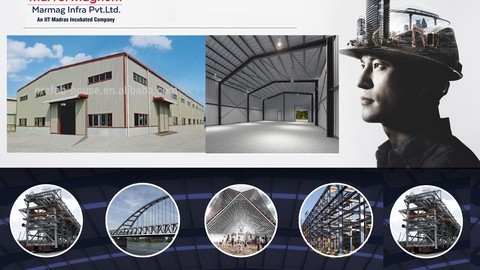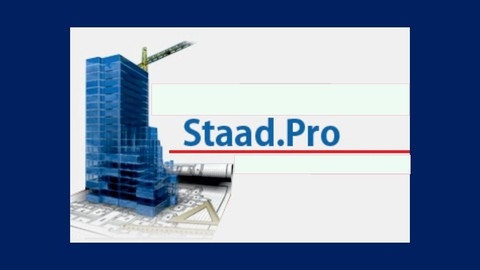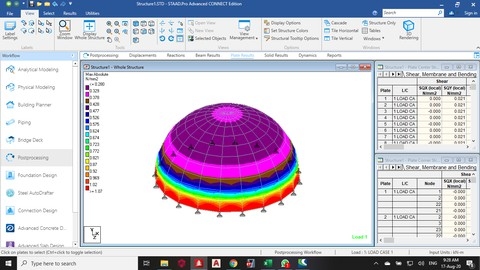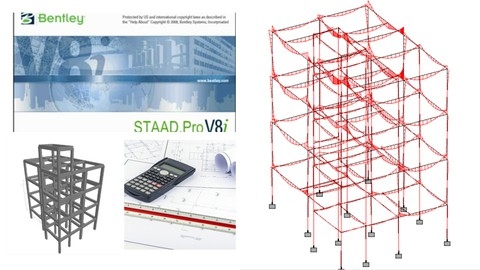STAAD.Pro is a powerful software used for structural analysis and design, making it a vital tool for engineers and professionals working in the construction and engineering industries.
By learning STAAD.Pro, you can gain the ability to model, analyze, and design a wide range of structures, from simple beams to complex buildings.
This knowledge opens up opportunities to take on challenging projects, optimize designs, and ensure structural integrity, leading to safer and more efficient constructions.
Finding the right STAAD.Pro course on Udemy can be overwhelming, with so many options available.
You want a program that is comprehensive, engaging, and taught by experienced professionals, but also fits your learning style and specific goals.
For the best STAAD.Pro course overall on Udemy, we recommend STAAD Pro: The Ultimate Beginner’s Guide.
This course stands out due to its comprehensive coverage of fundamental STAAD.Pro concepts, its practical approach with hands-on projects, and its focus on real-world applications.
It is suitable for beginners, covering everything from software basics to the design of common structural elements.
While this course is our top recommendation, there are other excellent options available depending on your specific interests and experience level.
Keep reading to explore more recommendations for beginner-friendly introductions, advanced courses, and courses focusing on specific areas like steel structures or composite materials.
STAAD Pro: The Ultimate Beginner’s Guide
This STAAD Pro course offers a comprehensive introduction to structural analysis and design, covering everything from setting up the software to designing complex structures.
You’ll start by mastering the fundamentals of STAAD Pro, learning how to create projects, navigate the various views and tools, and understand the program’s interface.
From there, you’ll dive into the analysis and design of common structural elements like beams, columns, and frames in both 2D and 3D.
The course walks you through the analysis of a reinforced concrete beam, step-by-step, explaining how to define nodes, draw the beam, assign sections, and apply loads.
You’ll then move on to analyzing and designing 2D frames, covering similar steps for creating and loading the structure.
The course culminates with a detailed exploration of 3D frame design, encompassing modeling, property assignment, load application, and analysis.
Beyond basic analysis, you’ll explore advanced tools like the Structure Wizard, enabling you to model various structural types, including frames and trusses.
The course also covers essential tools like Move, Rotate, and Mirror, allowing you to manipulate your models with precision.
You’ll learn to define new materials, leverage the Steel and Wood databases, and master concepts like moment releases and member offsets, all crucial for modeling intricate structures.
A key feature of the course is its focus on practical application.
You’ll be guided through modeling a building directly from architectural drawings, learning to interpret elevations, floor plans, and sections to create a realistic model.
The latter half of the course dives into structural element design, teaching you to design beams, columns, and slabs within STAAD Pro.
You’ll learn how to define design parameters, apply loads, and interpret the results to ensure your designs meet required specifications.
The course goes beyond basic design, exploring the design of footings, raft foundations, and staircases, rounding out your structural design knowledge.
You’ll also learn the basics of seismic analysis and design, covering key concepts like seismic code, dynamic analysis, and response spectrum analysis.
The course emphasizes practical application by guiding you through the application of wind loads and staircase loads to your models, making your designs more realistic.
While the course is comprehensive, it’s important to note that it focuses on the fundamentals and practical applications of STAAD Pro.
If you’re looking for a deep dive into advanced structural analysis or highly specialized design techniques, you may need to supplement this course with additional resources.
However, for those seeking a solid foundation in using STAAD Pro for structural analysis and design, this course provides a valuable starting point.
STAAD Pro Professional Course (Fresher to Experienced)
This STAAD Pro course offers a comprehensive journey for structural engineers, from the foundational elements of the software to advanced analysis techniques.
You’ll begin with the basics, navigating the interface, mastering modeling techniques, and understanding essential commands.
This foundation sets you up for success as you delve into more complex topics like modeling intricate structures and applying various types of loads.
The course shines with its emphasis on practical application.
You’ll model a school building and a watch tower, providing hands-on experience with real-world scenarios.
You’ll explore different types of structural analysis, including linear dynamic analysis, wind load generation, and buckling analysis.
Each module is carefully structured to ensure you gain proficiency in applying relevant standards such as ASCE 07 and IS 13920 for accurate calculations.
You’ll gain a deep understanding of designing and detailing structural elements like beams, columns, slabs, and foundations.
This robust foundation in practical structural engineering prepares you to confidently tackle real-world projects.
You’ll learn to apply both Indian and American standards, ensuring your designs are safe and compliant.
The course goes beyond the basics, exploring advanced topics such as pushover analysis, a powerful technique for evaluating the seismic performance of structures.
This comprehensive approach ensures you have the skills and knowledge to excel in your structural engineering endeavors.
STAAD Pro. - Structural Design of Steel Building (PEB)
If you’re looking to master structural design for steel buildings (PEBs) using STAAD Pro, this course offers a solid foundation.
It walks you through the entire process, from the fundamentals of PEB construction to the intricacies of advanced modeling and analysis.
You’ll gain a strong understanding of the different structural systems employed in PEBs, including common framing and bracing techniques.
The course then dives into the practical application of STAAD Pro, guiding you through the process of modeling complex structures and applying realistic loads.
You’ll learn to meticulously calculate dead, live, and wind loads, ensuring your designs meet structural integrity standards.
The course provides a clear explanation of the various analysis methods available in STAAD Pro, from linear to nonlinear techniques.
This understanding equips you to confidently assess the structural behavior of your designs.
You’ll delve deeper into critical design parameters, learning how to utilize STAAD Pro for strength and stability checks.
The course culminates in a valuable hands-on assignment where you create a complete STAAD Pro file for a real-world PEB structure.
This practical experience allows you to apply the knowledge you’ve gained and solidify your understanding of the design process.
Bentley STAAD Pro - Structural Analysis & Design Software
You’ll start by familiarizing yourself with the STAAD Pro’s interface and learning how to create basic structural elements, like beams and nodes.
You’ll delve into techniques for modifying existing beams, assigning material properties, and applying various types of loads to your structures.
The course goes beyond basic modeling, equipping you with advanced commands like Stretch, Mirror, and Circular Repeat for efficient manipulation of your designs.
You’ll learn how to import CAD files, copy and paste elements, and define references for complex structures.
You’ll also explore fundamental load calculations for buildings, including applying various types of loads to both plane frames and 3D structures.
Moving into practical applications, the course covers the analysis and design of steel structures.
You’ll use the Structure Wizards to quickly create truss structures and analyze them using the Snap Node approach.
You’ll also learn to analyze and design concrete structures, covering common elements like simply supported and overhanging beams, portal frames, and staircases.
The course further prepares you for analyzing more complex structural systems.
You’ll learn seismic analysis methods using the Seismic Coefficient and Response Spectrum approaches.
You’ll gain experience analyzing structures subjected to earthquakes, model shear walls, and even conduct Time History Analysis for dynamic loading scenarios.
The course culminates by showcasing how to analyze an elevated water tank, a critical component in many engineering projects.
STAAD Pro V8 Structural design of R.C building from A to Z
This comprehensive course dives deep into the world of structural design using STAAD Pro V8, covering both the fundamental principles and advanced techniques.
You’ll begin by mastering the core steps, including preparing AutoCAD files, defining sections, and creating supports.
The course then guides you through the meticulous process of applying various loads, such as uniform distributed loads, ensuring your models accurately reflect real-world conditions.
You’ll learn how to meticulously check and review your model before embarking on the analysis, and then interpret the results with confidence.
The course provides hands-on experience in designing beams and columns, allowing you to apply your knowledge to real-world scenarios.
But the training doesn’t stop there.
You’ll also delve into the crucial aspect of seismic design, learning how to incorporate earthquake loads into your structures using the static method.
The course explores a wide range of slab types, from waffle slabs to one-way ribbed slabs, flat slabs, and solid slabs.
You’ll gain a thorough understanding of the nuances of each type and learn how to model them effectively within STAAD Pro.
This course is a valuable investment for anyone seeking to develop their skills in this essential area of engineering.
STAAD Pro Professional Course(Steel Large Span Structures)
This course delves into the world of steel structures, particularly those with expansive spans, equipping you with the skills to design, analyze, and model them using STAAD Pro, a leading industry software.
Starting with the fundamentals, you’ll gain a strong foundation in steel truss structures, understanding their design principles according to AISC 360, a widely recognized standard.
You’ll also develop practical experience with manual design calculations for essential components like purlins and sag rods.
The course seamlessly transitions into STAAD Pro, guiding you through the process of modeling, analyzing, and designing steel trusses using this powerful tool.
You’ll explore advanced concepts like linear buckling analysis, a crucial method for determining the stability of steel structures under various loads.
The curriculum covers buckling analysis for different shapes, including I-shaped columns and girders, and even delves into a theoretical example of a cooling tower.
The focus then shifts to the design of pre-engineered buildings (PEBs), a prevalent type of steel structure.
You’ll learn to model PEB sheds, assign properties, and define load cases according to relevant Indian standards like IS 875 and NBC 2016.
The course also incorporates the assignment of wind loads as per IS 800.
You’ll gain expertise in designing lattice steel structures, often employed in large-span structures.
This encompasses everything from modeling and analysis to interpreting design results and optimizing the structure for efficiency.
You’ll also learn to design PEB portals, a key component of PEB structures, utilizing both AISC 360 and ASCE 07 standards, including a detailed explanation of wind loads according to ASCE 07-16.
Finally, the course introduces you to nonlinear static analysis, also known as pushover analysis.
This technique is used to assess the structural behavior of steel structures under extreme loads.
You’ll learn to perform pushover analysis in STAAD Pro and generate a pushover curve, which is essential for understanding the structure’s stability and collapse behavior.
While the course offers a comprehensive overview of steel structure design and analysis, its focus on practical applications and real-world scenarios makes it particularly valuable for those seeking to apply their knowledge in professional settings.
The use of STAAD Pro as a primary tool further strengthens its practical relevance.
However, the course’s depth and effectiveness may vary depending on your existing knowledge and experience in structural engineering.
Learn staad pro connect edition from the scratch
This comprehensive course is designed to equip you with the skills and knowledge needed to effectively utilize STAAD Pro Connect Edition for structural analysis and design.
The curriculum follows a logical progression, starting with the fundamentals of the software interface and gradually moving towards more advanced concepts and real-world applications.
You’ll learn to model and analyze a diverse range of structural elements, including beams, columns, trusses, plates, and slabs, with detailed instruction on how to design concrete and steel structures such as beams, columns, and even intricate staircases.
The course goes beyond the basics, delving into essential techniques like optimizing steel design, creating custom steel sections, and designing connections.
Throughout the course, you’ll tackle the design of common structures like free-standing staircases, continuous buildings, and even a crane gantry with moving loads.
You’ll gain a deep understanding of working with various materials, including concrete, steel, and double angles.
The curriculum doesn’t just focus on software; it also provides a solid foundation in structural concepts and their practical applications.
You’ll explore different load cases, wind loads, earthquake analysis, and learn to troubleshoot common errors.
The course also offers valuable insights into using the STAAD Command Editor, empowering you to work more efficiently and confidently.
By completing this course, you’ll acquire a comprehensive skillset in structural analysis and design using STAAD Pro Connect Edition, enabling you to confidently tackle a wide array of projects.
The Complete Course of STAAD Pro From zero to hero!
You’ll begin by getting acquainted with the software, downloading and installing it, and navigating its user-friendly interface.
The course dives deep into the heart of STAAD Pro – modeling.
You’ll master various modeling tools, starting with simple structures and progressing to complex multi-story buildings.
You’ll learn to import plans from AutoCAD and model a G+10 building step-by-step, incorporating real-world elements like staircases and lifts.
Beyond modeling, you’ll delve into critical structural design aspects.
You’ll define materials, assign support conditions, and learn to calculate and apply various loads, including dead, live, seismic, and wind loads.
You’ll gain a comprehensive understanding of design parameters for beams, columns, and slabs, solidifying your grasp of the entire structural design process.
STAAD Pro Professional Course(Composite & Cold Formed)
You’ll gain a solid understanding of the fundamental principles behind these structures and learn how to effectively model them within STAAD Pro.
The course delves into essential design codes such as AISC 360, ASCE 07, and ATC Hazards, equipping you with the knowledge to perform accurate and compliant analyses.
You’ll explore a range of structure types, including composite deck platforms and plate girders, learning how to model them with precision.
The course also covers advanced topics like linear and advanced cable analysis, expanding your skillset beyond basic structural modeling.
You’ll even delve into the design of cold-formed steel structures for solar panels, equipping you with specialized knowledge for a growing market.
A key highlight is the comprehensive coverage of P-Delta analysis, a crucial consideration for tall structures and those subjected to significant lateral loads.
You’ll gain the ability to perform this analysis confidently, ensuring the structural integrity and stability of your designs.
Additionally, you’ll be introduced to value engineering techniques, allowing you to optimize designs for cost-effectiveness without compromising safety or functionality.
Throughout the course, you’ll have ample opportunities to put theory into practice.
By working through numerous examples and simulations, you’ll gain proficiency in using STAAD Pro’s robust modeling, analysis, and design features.
The course is well-structured and provides clear explanations, making it accessible to both beginners and those with some prior experience in structural design.
While the course offers a strong foundation in composite and cold-formed steel structure design, it’s worth noting that it may not cover highly specialized or advanced applications in depth.
For those seeking in-depth knowledge of specific areas like seismic design or non-linear analysis, additional resources might be needed.
StaadPro V8i Structural Analysis & Design of a RCC Building
This Staad.Pro V8i course is a thorough introduction to structural analysis and design of reinforced concrete (RCC) buildings, particularly relevant for those working within Indian standards.
You’ll start by grasping the fundamentals of structural analysis and design, alongside the principles driving the Staad.Pro software.
The course dives deep into the software’s interface, teaching you to create models using tools like the Staad Editor and the Structure Wizard.
You’ll learn to import drawings from AutoCAD, ensuring seamless integration of your designs.
Beyond the software, you’ll gain a solid understanding of essential concepts like member and material properties, support conditions, and diverse loading types.
You’ll explore various load categories, including dead load, live load, seismic load, and wind load.
The syllabus delves into the complexities of seismic design, covering seismic load definitions and the process of defining response spectrum cases in Staad.Pro.
You’ll also gain insight into wind load calculations and definitions according to IS-875-Part-3, ensuring your designs comply with Indian standards.
The course isn’t solely focused on software; you’ll gain a comprehensive understanding of structural analysis concepts.
You’ll learn about structural members like footings, columns, beams, and slabs, and explore methods for determining their preliminary sizes.
You’ll also learn to convert architectural drawings to structural drawings, locate columns, and create a framing plan.
You’ll then move onto modeling your structure in Staad.Pro, checking your model for accuracy, and defining member properties and stiffness modifiers.
You’ll gain knowledge about stress-strain curves for concrete and steel, as well as the importance of assigning support conditions in your model.
This course seamlessly blends theory with practice.
You’ll learn how to define and assign design parameters, effectively bridging the gap between analysis and design.
The course features detailed explanations of design and detailing for various structural elements, including isolated footings, columns, eccentric footings, beams, and slabs.
You’ll be equipped to interpret results and gain a deep understanding of how these elements work together.
Your projects will meet relevant Indian Standards (IS Codes) like IS-1893, IS-456, and IS-875, ensuring your designs are both practical and compliant.










